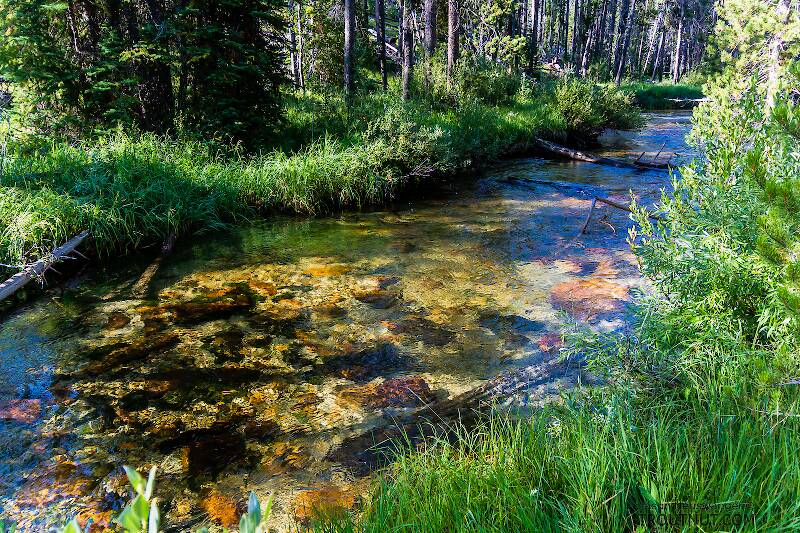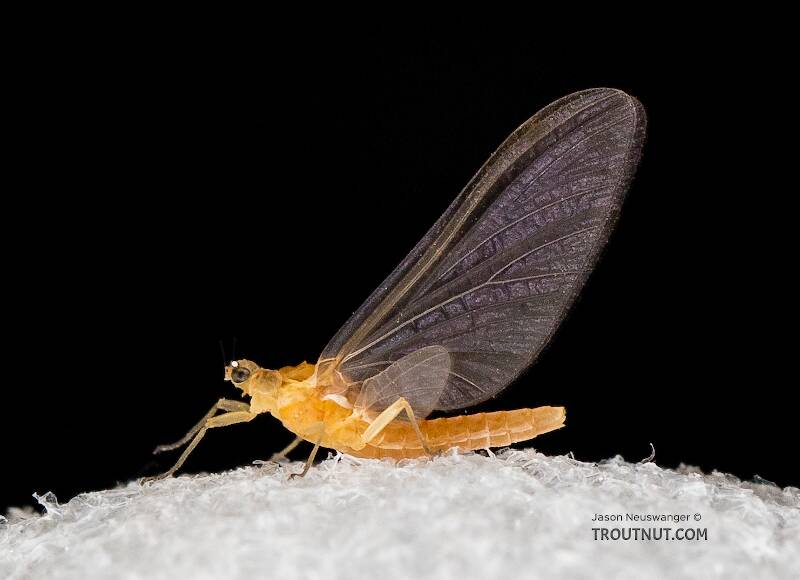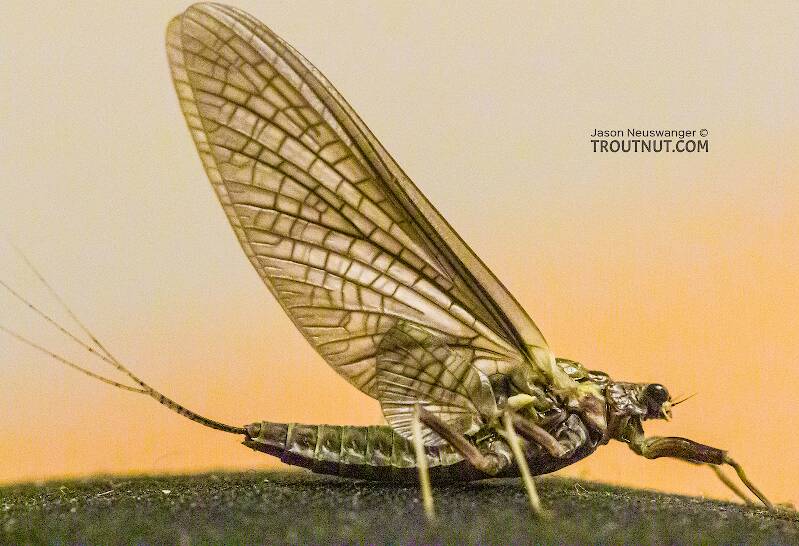
Salmonflies
Pteronarcys californica
The giant Salmonflies of the Western mountains are legendary for their proclivity to elicit consistent dry-fly action and ferocious strikes.
Featured on the forum

This dun emerged from a mature nymph on my desk. Unfortunately its wings didn't perfectly dry out.

Troutnut is a project started in 2003 by salmonid ecologist Jason "Troutnut" Neuswanger to help anglers and
fly tyers unabashedly embrace the entomological side of the sport. Learn more about Troutnut or
support the project for an enhanced experience here.
This topic is about the Mayfly Family Ephemerellidae
The Ephemerellidae are undoubtedly the most important family of mayflies for the American trout angler. Most species known as Hendricksons, Pale Morning Duns and Sulphurs belong to the genus Ephemerella in this family, while the genus Drunella lays claim to many Eastern and Western Blue-Winged Olives and the Western Green Drakes.Example specimens
CaseyP on May 2, 2008May 2nd, 2008, 5:17 am EDT
if the "sulphurs" from one stream are peach-colored, and from another are nearly white, are they the same or different bugs? would they hatch at different times?
as a tyer, i just make them different colors, but d'you think they would hatch at around the same week or so?
as a tyer, i just make them different colors, but d'you think they would hatch at around the same week or so?
"You can observe a lot by watching." Yogi Berra
LittleJ on May 2, 2008May 2nd, 2008, 6:07 am EDT
I know in pa the hatch, along with most mayfly hatches move north. So even if they are the same species depending on the location the hatch time could be seperated by a week or so. I'll defer to the experts but I would think that size would be better to use as a species indicator than subtle color changes. I also think that in my experience that color change matters very little, to the trout. Last season on the same river I fished both the peach color that a few people I know use , and the light yellow blend that I use, over the same hatch, and the results were the same.
Jeff
Jeff
Taxon on May 2, 2008May 2nd, 2008, 7:03 am EDT
Jeff,
The common name Sulphur is used variously to describe Epeorus vitreus, Ephemerella dorothea dorothea, and Ephemerella invaria. Neither size nor color would be an effective means of differentiating them, as both size and color vary depending on the sex of a given species, and there are size range overlaps between those the three species.
The common name Sulphur is used variously to describe Epeorus vitreus, Ephemerella dorothea dorothea, and Ephemerella invaria. Neither size nor color would be an effective means of differentiating them, as both size and color vary depending on the sex of a given species, and there are size range overlaps between those the three species.
GONZO on May 2, 2008May 2nd, 2008, 9:01 am EDT
Hi Casey,
Your questions provoke a "maybe yes, maybe no" answer.
Color and size for a species falls within a very general range. Color varies within that range from stream to stream, from male to female, and from dun to spinner. Size varies from stream to stream, from male to female, and (with extended hatches) from early in the hatching season to later in the hatching season.
Hatch timing for the same species in different streams or stream sections depends on seasonal temperature variations and the temperature regime of the stream. Streams with more stable temperatures (like limestone spring creeks) usually have more consistent and reliable hatch timing. Freestone streams are subject to broader fluctuations, both from season to season and from lower mainstem reaches into the headwaters. In either case, long-term temperature trends will affect hatch timing a little to a lot. (See the earlier discussions in the threads about "degree-days" and hatch timing for more.)
I know that isn't very helpful, but here are some specifics about the "sulphur" hatch(es) that might help:
Ephemerella invaria (includes the former E. rotunda)--This is the most tolerant, adaptable, and widespread of the "sulphurs." It is the main player in most of our region's streams. The larger female duns range from pale to bright yellow, often with secondary shades of olive or orange. Wings of duns range from very pale (almost white) to light bluish gray or medium milky gray. Males are smaller, darker, and have large orangish eyes. Male dun body colors range from tannish yellow to light or orangish brown. During the early part of the hatching season, females are typically in the #12-14 range and males in the #14-16 range. On streams with strong extended hatches, size diminishes to #16-18 for females and #18-20 for males. The hatch typically begins somewhere before or after mid-May, but that can vary widely from north to south, stream to stream, and season to season. On streams with heavy populations, the hatch can last well into June or even beyond.
Ephemerella dorothea dorothea--In much Eastern fly fishing literature, this species has been credited for the smaller, later "sulphur" hatch that overlaps or follows the invaria (rotunda) activity. Its habitat requirements seem to be narrower than invaria. Because of this, some of the activity attributed to this species may actually be extended invaria hatching. Female duns are typically bright to orangish yellow, sometimes with olive tones. Wings are very light to dirty gray, often with a hint of yellow along the leading edge. Male duns range from dark cream to tannish yellow with large red or reddish orange eyes. These little sulphurs seem to be more concentrated in slower water (pools) during the hatch. Hatching often begins in late May to early June, but varies with region, stream, and weather.
Ephemerella septentrionalis--This "sulphur," although fairly widespread, seems to have the narrowest habitat requirements of the three, and is probably the least likely to be encountered. It is fairly large, and because its hatching period overlaps invaria, it is easily mistaken for that species from a distance. However, the long spindly legs of both the nymph and adult easily distinguish it from invaria.
Other "sulphurlike" hatches:
Epeorus vitreus (sometimes misspelled as "vitrea")--This relative of the quill Gordon (Epeorus pleuralis) looks somewhat like a large sulphur from a distance, but is easily distinguished from them by the two tails (as opposed to three in the species above). The male duns are dull yellow with an olive or greenish cast. Dun wings are nearly white to very pale gray. The larger female duns (as large or slightly larger than invaria females) usually have bright pinkish orange or reddish abdomens reflecting the bright egg masses underneath. Because the hatching period overlaps the sulphurs, these "pink ladies" may share the water with them on suitable streams. Trout sometimes key into the bright vitreus females. Whenever I hear about hatches of "peach" or "coral" duns, I wonder if vitreus may be involved. Size is usually about #12-14, but later-hatching vitreus (into September on some streams) are #14-16. They emerge underwater, making wet-fly tactics important.
Other heptageniids--Some large to medium (#10-14) whitish or yellowish "Cahills" (mostly Maccaffertium species) may emerge with the sulphurs, but are easily distinguished by two tails and marked wings (usually dark hashmarks along the leading edge and middle of the wings). Additionally, some small, yellowish, "minor" heptageniids (mostly Leucrocuta species) might also be seen during the "sulphur" hatches. These are about the size of the dorothea or late invaria (#16-18). They have two tails, hashmarks on the wings, and often have brown markings on the back of their yellowish abdomens. The most significant of these, Leucrocuta hebe, usually follows the smaller sulphur hatches from sometime in late June, often extending into the fall.
I hope that helps, Casey.
Best,
Gonzo
Your questions provoke a "maybe yes, maybe no" answer.
Color and size for a species falls within a very general range. Color varies within that range from stream to stream, from male to female, and from dun to spinner. Size varies from stream to stream, from male to female, and (with extended hatches) from early in the hatching season to later in the hatching season.
Hatch timing for the same species in different streams or stream sections depends on seasonal temperature variations and the temperature regime of the stream. Streams with more stable temperatures (like limestone spring creeks) usually have more consistent and reliable hatch timing. Freestone streams are subject to broader fluctuations, both from season to season and from lower mainstem reaches into the headwaters. In either case, long-term temperature trends will affect hatch timing a little to a lot. (See the earlier discussions in the threads about "degree-days" and hatch timing for more.)
I know that isn't very helpful, but here are some specifics about the "sulphur" hatch(es) that might help:
Ephemerella invaria (includes the former E. rotunda)--This is the most tolerant, adaptable, and widespread of the "sulphurs." It is the main player in most of our region's streams. The larger female duns range from pale to bright yellow, often with secondary shades of olive or orange. Wings of duns range from very pale (almost white) to light bluish gray or medium milky gray. Males are smaller, darker, and have large orangish eyes. Male dun body colors range from tannish yellow to light or orangish brown. During the early part of the hatching season, females are typically in the #12-14 range and males in the #14-16 range. On streams with strong extended hatches, size diminishes to #16-18 for females and #18-20 for males. The hatch typically begins somewhere before or after mid-May, but that can vary widely from north to south, stream to stream, and season to season. On streams with heavy populations, the hatch can last well into June or even beyond.
Ephemerella dorothea dorothea--In much Eastern fly fishing literature, this species has been credited for the smaller, later "sulphur" hatch that overlaps or follows the invaria (rotunda) activity. Its habitat requirements seem to be narrower than invaria. Because of this, some of the activity attributed to this species may actually be extended invaria hatching. Female duns are typically bright to orangish yellow, sometimes with olive tones. Wings are very light to dirty gray, often with a hint of yellow along the leading edge. Male duns range from dark cream to tannish yellow with large red or reddish orange eyes. These little sulphurs seem to be more concentrated in slower water (pools) during the hatch. Hatching often begins in late May to early June, but varies with region, stream, and weather.
Ephemerella septentrionalis--This "sulphur," although fairly widespread, seems to have the narrowest habitat requirements of the three, and is probably the least likely to be encountered. It is fairly large, and because its hatching period overlaps invaria, it is easily mistaken for that species from a distance. However, the long spindly legs of both the nymph and adult easily distinguish it from invaria.
Other "sulphurlike" hatches:
Epeorus vitreus (sometimes misspelled as "vitrea")--This relative of the quill Gordon (Epeorus pleuralis) looks somewhat like a large sulphur from a distance, but is easily distinguished from them by the two tails (as opposed to three in the species above). The male duns are dull yellow with an olive or greenish cast. Dun wings are nearly white to very pale gray. The larger female duns (as large or slightly larger than invaria females) usually have bright pinkish orange or reddish abdomens reflecting the bright egg masses underneath. Because the hatching period overlaps the sulphurs, these "pink ladies" may share the water with them on suitable streams. Trout sometimes key into the bright vitreus females. Whenever I hear about hatches of "peach" or "coral" duns, I wonder if vitreus may be involved. Size is usually about #12-14, but later-hatching vitreus (into September on some streams) are #14-16. They emerge underwater, making wet-fly tactics important.
Other heptageniids--Some large to medium (#10-14) whitish or yellowish "Cahills" (mostly Maccaffertium species) may emerge with the sulphurs, but are easily distinguished by two tails and marked wings (usually dark hashmarks along the leading edge and middle of the wings). Additionally, some small, yellowish, "minor" heptageniids (mostly Leucrocuta species) might also be seen during the "sulphur" hatches. These are about the size of the dorothea or late invaria (#16-18). They have two tails, hashmarks on the wings, and often have brown markings on the back of their yellowish abdomens. The most significant of these, Leucrocuta hebe, usually follows the smaller sulphur hatches from sometime in late June, often extending into the fall.
I hope that helps, Casey.
Best,
Gonzo
CaseyP on May 2, 2008May 2nd, 2008, 10:34 am EDT
thanks, folks! this is great information, and you all managed not to confuse this tyro--i just love words of one syllable and simple concepts. now my tying will be much better targeted.
i'll keep an eye on those long spindly legs too, to see if the local ladies are really vitreus, or invaria.
now it seems that some of us have too much water and the rest not enough...roll on May!
i'll keep an eye on those long spindly legs too, to see if the local ladies are really vitreus, or invaria.
now it seems that some of us have too much water and the rest not enough...roll on May!
"You can observe a lot by watching." Yogi Berra
GONZO on May 2, 2008May 2nd, 2008, 11:08 am EDT
Along these lines, I'd call attention to two excellent articles in the most recent Fly Fisherman (the one with the gorgeous Little J brown on the cover). Eric Stroup discusses the Little J (including its sulphur hatch) and Paul Weamer writes about sulphurs. I'm sure the Little J crowd is familiar with Eric, and Paul recently abandoned his shop in the flood-ravaged Catskills for the State College area. (He now manages the TCO shops there.)
I was especially interested to read Paul's speculation about the possibility of Ephemerella dorothea and Epeorus vitreus being multi-brooded on the Delaware. My suspicion has always been that the later diminished hatches of both insects on the Delaware were caused by sudden cold-water releases in late May or early June. However, I'd be curious to know if anyone can report evidence of these (or other) ephemerellids or heptageniids being multi-brooded.
As an aside, I was pleased that both articles contained accurate and up-to-date information. I was a bit disappointed, however, when I turned to the article on Western green drakes and found them referred to as "Ephemerella grandis and Ephemerella dodsi [sic]." (And later in the article, "Ephemerella flavinea [sic].") Yes, I know it's nitpicking, but....
I was especially interested to read Paul's speculation about the possibility of Ephemerella dorothea and Epeorus vitreus being multi-brooded on the Delaware. My suspicion has always been that the later diminished hatches of both insects on the Delaware were caused by sudden cold-water releases in late May or early June. However, I'd be curious to know if anyone can report evidence of these (or other) ephemerellids or heptageniids being multi-brooded.
As an aside, I was pleased that both articles contained accurate and up-to-date information. I was a bit disappointed, however, when I turned to the article on Western green drakes and found them referred to as "Ephemerella grandis and Ephemerella dodsi [sic]." (And later in the article, "Ephemerella flavinea [sic].") Yes, I know it's nitpicking, but....
Quick Reply
Related Discussions
Topic
Replies
Last Reply
5
Aug 12, 2007
by Wbranch
by Wbranch
3
Jul 22, 2014
by Entoman
by Entoman
6
Nov 12, 2006
by Martinlf
by Martinlf
7
Jan 22, 2010
by Taxon
by Taxon
Re: Anyone know more about Ephemerella septentrionalis?
In the Mayfly Species Penelomax septentrionalis by Troutnut
In the Mayfly Species Penelomax septentrionalis by Troutnut
11
Jul 18, 2011
by Oldredbarn
by Oldredbarn






